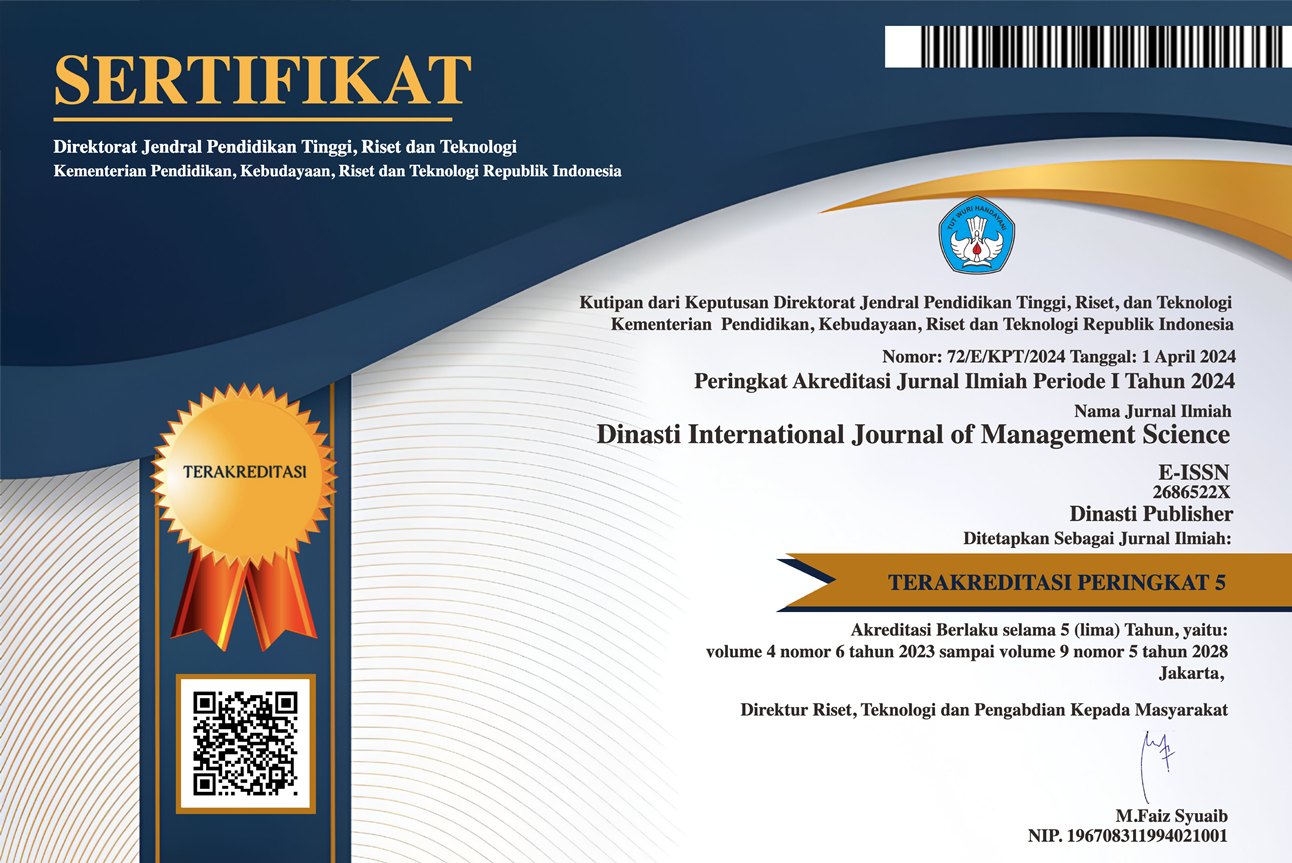HOW ENJOYMENT, TRUST IN INTENTION WHEN CHOOSING A SHOPPING PLACE
DOI:
https://doi.org/10.31933/dijms.v2i4.116Keywords:
Enjoyment, Trust and IntentionAbstract
The importance of analyzing the relationship between enjoyment and trust in consumer buying interest before making shopping decisions. This study used a sampling quota sampling technique with a survey method with a total sample size of 100 respondents from the city of Jakarta with the criteria for respondents who were over 20 years old. The results of the study indicate that enjoyment and trust influence consumer purchase orders. Therefore, a good marketer must build these two factors in the place of shopping because they can trigger requests to buy and later become a stimulus in purchasing decisions.
References
Chen, M. Y., & Teng, C. I. (2013). A comprehensive model of the effects of online store image on purchase intention in an e-commerce environment. Electronic Commerce Research, 13(1), 1–23. https://doi.org/10.1007/s10660-013-9104-5
Cho, E., & Son, J. (2019). The effect of social connectedness on consumer adoption of social commerce in apparel shopping. Fashion and Textiles, 6(1), Pp. 1-17. https://doi.org/10.1186/s40691-019-0171-7
Ferdinand, A. (2018). Metode penelitian manajemen. Universitas Diponegoro.
Indarsin, T., & Ali, H. (2017). Attitude toward Using m-Commerce: The Analysis of Perceived Usefulness Perceived Ease of Use, and Perceived Trust: Case Study in Ikens Wholesale Trade, Jakarta – Indonesia. Saudi Journal of Business and Management Studies, Vol-2,(Iss-11 (Nov, 2017)), pp: 995-1007. https://doi.org/10.21276/sjbms.2017.2.11.7
Kotler, P., & Amstrong, gary. (2016). Prinsip-prinsip Pemasaran. Edisi13. Jilid 1. Erlangga.
Kotler, P., Kartajaya, H., & Setiawan, I. (2019). Marketing 4.0: Moving From Traditional To Digital. In Gramedia. PT. Gramedia Pustaka Utama. https://doi.org/10.1142/9789813275478_0004
Marriott, H. R., & Williams, M. D. (2018). Exploring consumers perceived risk and trust for mobile shopping: A theoretical framework and empirical study. Journal of Retailing and Consumer Services, 42, 133–146. https://doi.org/10.1016/j.jretconser.2018.01.017
Reyes-Mercado, P., Karthik, M., Mishra, R. K., & Rajagopal. (2017). Drivers of consumer attitudes towards online shopping in the Indian market: Analysis through an extended TAM model. International Journal of Business Innovation and Research, 13(3), 326–343. https://doi.org/10.1504/IJBIR.2017.10005068
Solomon, M. R. (2018). Consumer Behavior: Buying, Having, and Being. 12th Edition. Pearson Education Limited .
Suleman, D. (2018). Faktor Penentu Keputusan Konsumen Indonesia MemilihTempat Belanja Disebuah E-Commerce (Theory of Planned Behavior). Jurnal JDM, I(02), 1–9. http://journal.mercubuana.ac.id/index.php/jdm/article/view/4120
Suleman, D., Ali, H., Nusraningrum, D., & Ali, M. M. (2020a). Consumer Behaviour in the Marketing 4.0 Era Regarding Decisions about Where to Shop. International Journal of Innovation, Creativity and Change, 13(7), Pp : 444-456. https://www.ijicc.net/images/vol_13/Iss_7/13763_Suleman_2020_E_R.pdf
Suleman, D., Ali, H., Nusraningrum, D., & Ali, M. M. (2020b). Consumer Factors in Choosing Shopping Place in 4.0. JURNAL MANAJEMEN DAN BISNIS SRIWIJAYA, 17(4), 193–198. https://doi.org/DOI: https://doi.org/10.29259/jmbs.v17i4.11529
Suleman, D., Ali, H., Nusraningrum, D., & Ali, M. M. (2020c). Faktor konsumen dalam memilih tempat belanja di Era 4.0. At-Tijaroh, 6(1), Pp : 37-44.
Suleman, D., Ali, H., Nusraningrum, D., & Ali, M. M. (2020d). Strategi memenangkan persaingan bisnis berbasis perilaku konsumen untuk produk fashion. Lembaga pendidikan dan pelatihan balai insan cendekia.
Suleman, D., Ali, H., Nusraningrum, D., & Ali, M. M. A. (2019). Perceived Ease of Use, Trust and Risk toward Attitude and Intention in Shopping for Online Fashion Products In Indonesia. Archives of Business Research, Vol.7(No.4), pp.240-253. https://doi.org/DOI: http://dx.doi.org/10.14738/abr.74.2019
Suleman, D., Ali, H., Nusraningrum, D., & Ali, M. M. A. (2020e). Pembeda Konsumen Dalam Memilih Tempat Belanja Offline Vs Online. Ecodemica, 4(2), 275–282.
Suleman, D., Suharyadi, D., Marwansyah, S., Rachmawati, S., Rusiyati, S., & Sabil, S. (2020). The effect of ease of use, risks towards consumer decisions when shopping online. Dinasti International Journal of Economics, Finance & Accounting, 1(4), 722–726. https://doi.org/DOI:10.38035/DIJEFA
Suleman, D., Suharyadi, D., Rusiyati, S., Sabil, Riftiasari, D., & Marwansyah, S. (2020). How trust,risk toward attitude when shopping retail online. Dinasti International Journal of Education Management and Social Science, 1(4), Pp :487-492. https://doi.org/https://doi.org/10.31933/dijms.v1i4.185
Suleman, D., Zuniarti, I., Marginingsih, R., Sabil, Nurhayaty, E., Rachmawati, S., Pramularso, E. Y., & Sari, I. (2019). Competition between offline and online stores: when it comes to shopping for fashion products, which store will be the choice of Indonesian consumers? International Conference on Global Innovation and Trends in Economy, 1–14. https://easychair.org/publications/preprint/8drP
Suleman, D., Zuniarti, I., Marginingsih, R., Susilowati, I. H., Sari, I., Sabil, S., & Nurhayaty, E. (2020). The effect of decision to purchase on shop fashion product in Indonesia mediated by attitude to shop. Management Science Letters, 11(1), 111–116. https://doi.org/doi: 10.5267/j.msl.2020.8.024
Suleman, D., Zuniarti, I., & Sabil, S. (2019). Consumer Decisions toward Fashion Product Shopping in Indonesia: The effects of Attitude, Perception of Ease of Use, Usefulness, and Trust. Management Dynamics in the Knowledge Economy, 7(2), 133–146. https://doi.org/10.25019/mdke/7.2.01
Suleman, D., Zuniarti, I., Setyaningsih, E. D., Yanti, V. A., Susilowati, I. H., Sari, I., Marwansyah, S., Hadi, S. sudarmono, & Lestiningsih, A. S. (2019). Decision Model Based on Technology Acceptance Model (Tam) for Online Shop Consumers in Indonesia. Academy of Marketing Studies Journal, 23(4), Pp: 1-14. https://www.abacademies.org/articles/decision-model-based-on-technology-acceptance-model-tam-for-online-shop-consumers-in-indonesia-8624.html
Xiang, L., Zheng, X., Lee, M. K. O., & Zhao, D. (2016). Exploring consumers’ impulse buying behavior on social commerce platform: The role of parasocial interaction. International Journal of Information Management, 36(3), 333–347. https://doi.org/10.1016/j.ijinfomgt.2015.11.002
Zeba, F., & Ganguli, S. (2016). Word-of-mouth, trust, and perceived risk in online shopping: An extension of the technology acceptance model. International Journal of Information Systems in the Service Sector, 8(4), 17–32. https://doi.org/10.4018/IJISSS.2016100102
Chen, M. Y., & Teng, C. I. (2013). A comprehensive model of the effects of online store image on purchase intention in an e-commerce environment. Electronic Commerce Research, 13(1), 1–23. https://doi.org/10.1007/s10660-013-9104-5
Cho, E., & Son, J. (2019). The effect of social connectedness on consumer adoption of social commerce in apparel shopping. Fashion and Textiles, 6(1), Pp. 1-17. https://doi.org/10.1186/s40691-019-0171-7
Ferdinand, A. (2018). Metode penelitian manajemen. Universitas Diponegoro.
Indarsin, T., & Ali, H. (2017). Attitude toward Using m-Commerce: The Analysis of Perceived Usefulness Perceived Ease of Use, and Perceived Trust: Case Study in Ikens Wholesale Trade, Jakarta – Indonesia. Saudi Journal of Business and Management Studies, Vol-2,(Iss-11 (Nov, 2017)), pp: 995-1007. https://doi.org/10.21276/sjbms.2017.2.11.7
Kotler, P., & Amstrong, gary. (2016). Prinsip-prinsip Pemasaran. Edisi13. Jilid 1. Erlangga.
Kotler, P., Kartajaya, H., & Setiawan, I. (2019). Marketing 4.0: Moving From Traditional To Digital. In Gramedia. PT. Gramedia Pustaka Utama. https://doi.org/10.1142/9789813275478_0004
Marriott, H. R., & Williams, M. D. (2018). Exploring consumers perceived risk and trust for mobile shopping: A theoretical framework and empirical study. Journal of Retailing and Consumer Services, 42, 133–146. https://doi.org/10.1016/j.jretconser.2018.01.017
Reyes-Mercado, P., Karthik, M., Mishra, R. K., & Rajagopal. (2017). Drivers of consumer attitudes towards online shopping in the Indian market: Analysis through an extended TAM model. International Journal of Business Innovation and Research, 13(3), 326–343. https://doi.org/10.1504/IJBIR.2017.10005068
Solomon, M. R. (2018). Consumer Behavior: Buying, Having, and Being. 12th Edition. Pearson Education Limited .
Suleman, D. (2018). Faktor Penentu Keputusan Konsumen Indonesia MemilihTempat Belanja Disebuah E-Commerce (Theory of Planned Behavior). Jurnal JDM, I(02), 1–9. http://journal.mercubuana.ac.id/index.php/jdm/article/view/4120
Suleman, D., Ali, H., Nusraningrum, D., & Ali, M. M. (2020a). Consumer Behaviour in the Marketing 4.0 Era Regarding Decisions about Where to Shop. International Journal of Innovation, Creativity and Change, 13(7), Pp : 444-456. https://www.ijicc.net/images/vol_13/Iss_7/13763_Suleman_2020_E_R.pdf
Suleman, D., Ali, H., Nusraningrum, D., & Ali, M. M. (2020b). Consumer Factors in Choosing Shopping Place in 4.0. JURNAL MANAJEMEN DAN BISNIS SRIWIJAYA, 17(4), 193–198. https://doi.org/DOI: https://doi.org/10.29259/jmbs.v17i4.11529
Suleman, D., Ali, H., Nusraningrum, D., & Ali, M. M. (2020c). Faktor konsumen dalam memilih tempat belanja di Era 4.0. At-Tijaroh, 6(1), Pp : 37-44.
Suleman, D., Ali, H., Nusraningrum, D., & Ali, M. M. (2020d). Strategi memenangkan persaingan bisnis berbasis perilaku konsumen untuk produk fashion. Lembaga pendidikan dan pelatihan balai insan cendekia.
Suleman, D., Ali, H., Nusraningrum, D., & Ali, M. M. A. (2019). Perceived Ease of Use, Trust and Risk toward Attitude and Intention in Shopping for Online Fashion Products In Indonesia. Archives of Business Research, Vol.7(No.4), pp.240-253. https://doi.org/DOI: http://dx.doi.org/10.14738/abr.74.2019
Suleman, D., Ali, H., Nusraningrum, D., & Ali, M. M. A. (2020e). Pembeda Konsumen Dalam Memilih Tempat Belanja Offline Vs Online. Ecodemica, 4(2), 275–282.
Suleman, D., Suharyadi, D., Marwansyah, S., Rachmawati, S., Rusiyati, S., & Sabil, S. (2020). The effect of ease of use, risks towards consumer decisions when shopping online. Dinasti International Journal of Economics, Finance & Accounting, 1(4), 722–726. https://doi.org/DOI:10.38035/DIJEFA
Suleman, D., Suharyadi, D., Rusiyati, S., Sabil, Riftiasari, D., & Marwansyah, S. (2020). How trust,risk toward attitude when shopping retail online. Dinasti International Journal of Education Management and Social Science, 1(4), Pp :487-492. https://doi.org/https://doi.org/10.31933/dijms.v1i4.185
Suleman, D., Zuniarti, I., Marginingsih, R., Sabil, Nurhayaty, E., Rachmawati, S., Pramularso, E. Y., & Sari, I. (2019). Competition between offline and online stores: when it comes to shopping for fashion products, which store will be the choice of Indonesian consumers? International Conference on Global Innovation and Trends in Economy, 1–14. https://easychair.org/publications/preprint/8drP
Suleman, D., Zuniarti, I., Marginingsih, R., Susilowati, I. H., Sari, I., Sabil, S., & Nurhayaty, E. (2020). The effect of decision to purchase on shop fashion product in Indonesia mediated by attitude to shop. Management Science Letters, 11(1), 111–116. https://doi.org/doi: 10.5267/j.msl.2020.8.024
Suleman, D., Zuniarti, I., & Sabil, S. (2019). Consumer Decisions toward Fashion Product Shopping in Indonesia: The effects of Attitude, Perception of Ease of Use, Usefulness, and Trust. Management Dynamics in the Knowledge Economy, 7(2), 133–146. https://doi.org/10.25019/mdke/7.2.01
Suleman, D., Zuniarti, I., Setyaningsih, E. D., Yanti, V. A., Susilowati, I. H., Sari, I., Marwansyah, S., Hadi, S. sudarmono, & Lestiningsih, A. S. (2019). Decision Model Based on Technology Acceptance Model (Tam) for Online Shop Consumers in Indonesia. Academy of Marketing Studies Journal, 23(4), Pp: 1-14. https://www.abacademies.org/articles/decision-model-based-on-technology-acceptance-model-tam-for-online-shop-consumers-in-indonesia-8624.html
Xiang, L., Zheng, X., Lee, M. K. O., & Zhao, D. (2016). Exploring consumers’ impulse buying behavior on social commerce platform: The role of parasocial interaction. International Journal of Information Management, 36(3), 333–347. https://doi.org/10.1016/j.ijinfomgt.2015.11.002
Zeba, F., & Ganguli, S. (2016). Word-of-mouth, trust, and perceived risk in online shopping: An extension of the technology acceptance model. International Journal of Information Systems in the Service Sector, 8(4), 17–32. https://doi.org/10.4018/IJISSS.2016100102
Chen, M. Y., & Teng, C. I. (2013). A comprehensive model of the effects of online store image on purchase intention in an e-commerce environment. Electronic Commerce Research, 13(1), 1–23. https://doi.org/10.1007/s10660-013-9104-5
Cho, E., & Son, J. (2019). The effect of social connectedness on consumer adoption of social commerce in apparel shopping. Fashion and Textiles, 6(1), Pp. 1-17. https://doi.org/10.1186/s40691-019-0171-7
Indarsin, T., & Ali, H. (2017). Attitude toward Using m-Commerce: The Analysis of Perceived Usefulness Perceived Ease of Use, and Perceived Trust: Case Study in Ikens Wholesale Trade, Jakarta – Indonesia. Saudi Journal of Business and Management Studies, Vol-2,(Iss-11 (Nov, 2017)), pp: 995-1007. https://doi.org/10.21276/sjbms.2017.2.11.7
Kotler, P., & Amstrong, gary. (2016). Prinsip-prinsip Pemasaran. Edisi13. Jilid 1. Erlangga.
Kotler, P., Kartajaya, H., & Setiawan, I. (2019). Marketing 4.0: Moving From Traditional To Digital. In Gramedia. PT. Gramedia Pustaka Utama. https://doi.org/10.1142/9789813275478_0004
Marriott, H. R., & Williams, M. D. (2018). Exploring consumers perceived risk and trust for mobile shopping: A theoretical framework and empirical study. Journal of Retailing and Consumer Services, 42, 133–146. https://doi.org/10.1016/j.jretconser.2018.01.017
Reyes-Mercado, P., Karthik, M., Mishra, R. K., & Rajagopal. (2017). Drivers of consumer attitudes towards online shopping in the Indian market: Analysis through an extended TAM model. International Journal of Business Innovation and Research, 13(3), 326–343. https://doi.org/10.1504/IJBIR.2017.10005068
Solomon, M. R. (2018). Consumer Behavior: Buying, Having, and Being. 12th Edition. Pearson Education Limited .
Sugiyono. (2013). Metode penelitian manajemen. Badan Penerbit Universitas Diponegoro.
Suleman, D. (2018). Faktor Penentu Keputusan Konsumen Indonesia MemilihTempat Belanja Disebuah E-Commerce (Theory of Planned Behavior). Jurnal JDM, I(02), 1–9. http://journal.mercubuana.ac.id/index.php/jdm/article/view/4120
Suleman, D., Ali, H., Nusraningrum, D., & Ali, M. M. (2020a). Consumer Behaviour in the Marketing 4.0 Era Regarding Decisions about Where to Shop. International Journal of Innovation, Creativity and Change, 13(7), Pp : 444-456. https://www.ijicc.net/images/vol_13/Iss_7/13763_Suleman_2020_E_R.pdf
Suleman, D., Ali, H., Nusraningrum, D., & Ali, M. M. (2020b). Consumer Factors in Choosing Shopping Place in 4.0. JURNAL MANAJEMEN DAN BISNIS SRIWIJAYA, 17(4), 193–198. https://doi.org/DOI: https://doi.org/10.29259/jmbs.v17i4.11529
Suleman, D., Ali, H., Nusraningrum, D., & Ali, M. M. (2020c). Faktor konsumen dalam memilih tempat belanja di Era 4.0. At-Tijaroh, 6(1), Pp : 37-44.
Suleman, D., Ali, H., Nusraningrum, D., & Ali, M. M. (2020d). Strategi memenangkan persaingan bisnis berbasis perilaku konsumen untuk produk fashion. Lembaga pendidikan dan pelatihan balai insan cendekia.
Suleman, D., Ali, H., Nusraningrum, D., & Ali, M. M. A. (2019). Perceived Ease of Use, Trust and Risk toward Attitude and Intention in Shopping for Online Fashion Products In Indonesia. Archives of Business Research, Vol.7(No.4), pp.240-253. https://doi.org/DOI: http://dx.doi.org/10.14738/abr.74.2019
Suleman, D., Ali, H., Nusraningrum, D., & Ali, M. M. A. (2020e). Pembeda Konsumen Dalam Memilih Tempat Belanja Offline Vs Online. Ecodemica, 4(2), 275–282.
Suleman, D., Suharyadi, D., Marwansyah, S., Rachmawati, S., Rusiyati, S., & Sabil, S. (2020). The effect of ease of use, risks towards consumer decisions when shopping online. Dinasti International Journal of Economics, Finance & Accounting, 1(4), 722–726. https://doi.org/DOI:10.38035/DIJEFA
Suleman, D., Suharyadi, D., Rusiyati, S., Sabil, Riftiasari, D., & Marwansyah, S. (2020). How trust,risk toward attitude when shopping retail online. Dinasti International Journal of Education Management and Social Science, 1(4), Pp :487-492. https://doi.org/https://doi.org/10.31933/dijms.v1i4.185
Suleman, D., Zuniarti, I., Marginingsih, R., Sabil, Nurhayaty, E., Rachmawati, S., Pramularso, E. Y., & Sari, I. (2019). Competition between offline and online stores: when it comes to shopping for fashion products, which store will be the choice of Indonesian consumers? International Conference on Global Innovation and Trends in Economy, 1–14. https://easychair.org/publications/preprint/8drP
Suleman, D., Zuniarti, I., Marginingsih, R., Susilowati, I. H., Sari, I., Sabil, S., & Nurhayaty, E. (2020). The effect of decision to purchase on shop fashion product in Indonesia mediated by attitude to shop. Management Science Letters, 11(1), 111–116. https://doi.org/doi: 10.5267/j.msl.2020.8.024
Suleman, D., Zuniarti, I., & Sabil, S. (2019). Consumer Decisions toward Fashion Product Shopping in Indonesia: The effects of Attitude, Perception of Ease of Use, Usefulness, and Trust. Management Dynamics in the Knowledge Economy, 7(2), 133–146. https://doi.org/10.25019/mdke/7.2.01
Suleman, D., Zuniarti, I., Setyaningsih, E. D., Yanti, V. A., Susilowati, I. H., Sari, I., Marwansyah, S., Hadi, S. sudarmono, & Lestiningsih, A. S. (2019). Decision Model Based on Technology Acceptance Model (Tam) for Online Shop Consumers in Indonesia. Academy of Marketing Studies Journal, 23(4), Pp: 1-14. https://www.abacademies.org/articles/decision-model-based-on-technology-acceptance-model-tam-for-online-shop-consumers-in-indonesia-8624.html
Xiang, L., Zheng, X., Lee, M. K. O., & Zhao, D. (2016). Exploring consumers’ impulse buying behavior on social commerce platform: The role of parasocial interaction. International Journal of Information Management, 36(3), 333–347. https://doi.org/10.1016/j.ijinfomgt.2015.11.002
Zeba, F., & Ganguli, S. (2016). Word-of-mouth, trust, and perceived risk in online shopping: An extension of the technology acceptance model. International Journal of Information Systems in the Service Sector, 8(4), 17–32. https://doi.org/10.4018/IJISSS.2016100102
Downloads
Published
How to Cite
Issue
Section
License
Authors who publish their manuscripts in this journal agree to the following conditions:
- The copyright on each article belongs to the author(s).
- The author acknowledges that the Dinasti International Journal of Management Science (DIJMS) has the right to be the first to publish with a Creative Commons Attribution 4.0 International license (Attribution 4.0 International (CC BY 4.0).
- Authors can submit articles separately, arrange for the non-exclusive distribution of manuscripts that have been published in this journal into other versions (e.g., sent to the author's institutional repository, publication into books, etc.), by acknowledging that the manuscript has been published for the first time in the Dinasti International Journal of Management Science (DIJMS).
















































